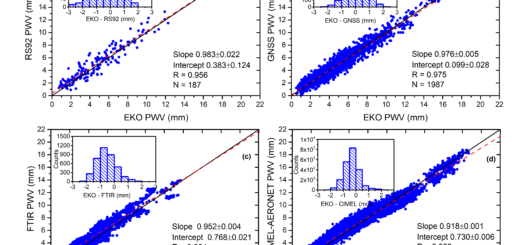PhD Presentation of Rosa Delia García-Cabrera
![]()
Dr. Rosa García-Cabrera (UVA-AEMET) with her supervisors, Dr. Victoria Cachorro (UVA) and Dr. Emilio Cuevas (AEMET)
Dr. Rosa Delia García Cabrera defended her PhD Thesis entitled “RADIATIVE MODEL APPLICATION FOR THE OPERATIVE CONTROL OF THE BSRN (Baseline Surface Radiation Network) PROGRAM AT THE IZAÑA ATMOSPHERIC RESEARCH CENTER” on December 16 at the University of Valladolid, earning the top rating of “Cum Laude” .This thesis has been supervised by Dr. Victoria Eugenia Cachorro Revilla, from the Applied Physics Department at the Valladolid University, and Dr. Emilio Cuevas Agulló, Director of the Izaña Atmospheric Research Center (AEMET). This thesis was carried out as part of the PhD program in Advanced Methods for Modern Physics.
The PhD Thesis can be downloaded here (in Spanish).
The presentation of the PhD dissertation can be downloaded here (in Spanish).
The Doctoral Thesis Committee was:
President: Prof. Dr. Santiago Mar-Sardaña, Professor at the University of Valladolid
Secretary: Dr. Carlos Toledano-Olmeda, Ramón y Cajal Contract at the University of Valladolid
Examiner 1: Dr. Omaira García-Rodríguez, Izaña Atmospheric Research Center (AEMET)
Examiner 2: Prof. Dr. María del Pilar Utrillas-Esteban, Professor at the University of Valencia
Examiner 3: Prof. Lucas Alados-Arboledas, Professor at the University of Granada
From right to left: Dr. Carlos Toledano (UVA), Dr. Pilar Utrillas (UV), Dr. Rosa García-Cabrera (UVA/AEMET), Dr. Santiago Mar (UVA), Dra. Omaira García (AEMET), and Dr. Lucas Alados (UGR).
At present time Dr. García works at the Izaña Atmospheric Research Center within the collaboration agreement between AEMET and the University of Valladolid (GOA-UVA). Her work is centered in the analysis, evaluation and development of methodologies for spectral and integrated solar radiation measurements in different spectral ranges (UV, visible and IR). She is also in charge on methodologies of calibration of specific radiation instruments, quality control (as required by the BSRN network), and the application of radiative transference modelling in order to evaluate experimental data quality, and for data rescue and long term series reconstruction.
PhD Thesis abstract
In 1984 the Izaña Atmospheric Research was incorporated into the Background Air Pollution Monitoring Network (BAPMoN) and in 1989 it became part of the Global Atmospheric Watch programme (GAW). In 2009 the Izaña Station was accepted as a member of the Baseline Surface Radiation Network (BSRN). This network is a project of the Radiation Panel from the Global Energy and Water Cycle Experiment (GEWEX) under the umbrella of the World Climate Research Program (WRCP). The objective of BSRN is to provide high quality observations of shortwave and longwave surface radiation, fluxes, with high temporal resolution (one to three minutes), to characterize the Earth’s radiation field and detect long-term trends.
In this work we analyze the solar radiation components, global, direct and diffuse, measured at the Izaña Station. Firstly we focus on the main BSRN methodologies, algorithms and techniques, as well as the application of quality controls to the measurements.
One of the main objectives of this work is to study the capabilities of the LibRadtran radiative transfer package for modeling the solar radiation field, in order to apply it in the quality control protocol and the solar radiation series reconstruction. A sensitivity study for the LibRadtran model was conducted, the performance of simulated radiation versus changes in the atmospheric parameters was evaluated. After that a comparison between measured and simulated radiation for cloud-free sky days with typical atmospheric conditions at the Izaña station was carried out for 2009 and 2010. A reconstruction of the Izaña global solar radiation series since 1992 was made using insolation measurements for the lost periods. Subsequently a trend analysis for the reconstructed global radiation series was performed.
Finally a study of the aerosol forcing and the aerosol forcing efficiency in the global, direct and diffuse radiation at the Izaña station during 2009 and 2010 was conducted. We compared the obtained aerosol forcing and the aerosol forcing efficiency with values provided from the AERONET network (AErosol RObotic NETwork) for global radiation at a solar zenith angle of 60°.
All the algorithms, techniques and methodologies developed in this work may be implemented in any station that wants to be part of the BSRN network.







